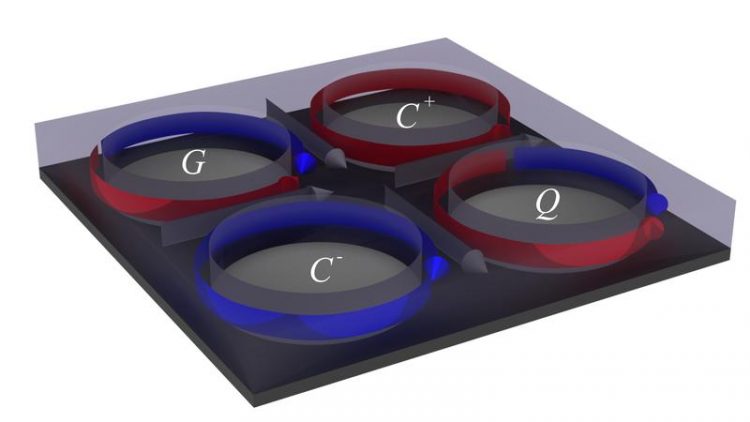Three Magnetic States for Each Hole

Researchers at the HZDR have calculated that the specific layout of four holes ("antidots") in a layer of cobalt will accommodate 15 different combinations for programming. HZDR
Physicist Dr. Rantej Bali from the HZDR, together with scientists from Singapore and Australia, designed a special grid structure in a thin layer of cobalt in order to program its magnetic properties. His colleagues from the National University in Singapore produced the grid using a photolithographic process similar to that currently used in chip manufacture.
Approximately 250 nanometers sized holes, so-called antidots, were created at regular intervals – with interspaces of only 150 nanometers – in the cobalt layer. In order to be able to stably program it, the Singapore experts followed the Dresden design, which specified a metal layer thickness of approximately 50 nanometers.
At these dimensions the cobalt antidot grid displayed interesting properties: Dr. Bali’s team discovered that with the aid of an externally applied magnetic field three distinct magnetic states around each hole could be configured. The scientists called these states “G”, “C” and “Q”. Dr. Bali: “Antidots are now in the international research spotlight. By optimizing the antidot geometry we were able to show that the spins, or the magnetic moments of the electrons, could be reliably programmed around the holes.”
Building blocks for future logic
Since the individually programmable holes are situated in a magnetic metal layer, the grid geometry has potential use in computers that would work with spin-waves instead of electric current. “Spin-waves are similar to the so-called Mexican waves you see in a football stadium. The wave propagates through the stadium, but the individual fans, in our case the electrons, stay seated”, explains Dr. Bali. Logic chips utilizing such spin-waves would use far less power than today’s processors, because no electrical current is involved.
Many magnetic states can be realized in the perforated grid so that the spin-waves can, for example, be assigned specific directions. This could allow for a higher processing speed in future logic chips. “Our perforated grids could also operate as components for future circuits working with spin-waves“, estimates Dr. Bali.
Doctoral candidate, Tobias Schneider, is now investigating the dynamics developed by the spin-waves in such perforated grids. Among other aspects he is participating in the development of special computer programs making possible the complex calculation of the magnetic states in perforated grids.
Publication: T. Schneider, R. Bali u. a.: „Programmability of Co-antidot Lattices of Optimized Geometry“, Scientific Reports Nr. 7, Article number: 41157 (2017), DOI: 10.1038/srep41157
Further information:
Dr. Rantej Bali | Tobias Schneider
Phone +49 351 260-2919 | -2689
Email: r.bali@hzdr.de | t.schneider@hzdr.de
Media contact:
Dr. Christine Bohnet | Press officer & head HZDR communications
Phone +49 351 260-2450 | Email: c.bohnet@hzdr.de
Helmholtz-Zentrum Dresden-Rossendorf | Bautzner Landstr. 400 | 01328 Dresden
Media Contact
All latest news from the category: Physics and Astronomy
This area deals with the fundamental laws and building blocks of nature and how they interact, the properties and the behavior of matter, and research into space and time and their structures.
innovations-report provides in-depth reports and articles on subjects such as astrophysics, laser technologies, nuclear, quantum, particle and solid-state physics, nanotechnologies, planetary research and findings (Mars, Venus) and developments related to the Hubble Telescope.
Newest articles

A universal framework for spatial biology
SpatialData is a freely accessible tool to unify and integrate data from different omics technologies accounting for spatial information, which can provide holistic insights into health and disease. Biological processes…

How complex biological processes arise
A $20 million grant from the U.S. National Science Foundation (NSF) will support the establishment and operation of the National Synthesis Center for Emergence in the Molecular and Cellular Sciences (NCEMS) at…

Airborne single-photon lidar system achieves high-resolution 3D imaging
Compact, low-power system opens doors for photon-efficient drone and satellite-based environmental monitoring and mapping. Researchers have developed a compact and lightweight single-photon airborne lidar system that can acquire high-resolution 3D…





















